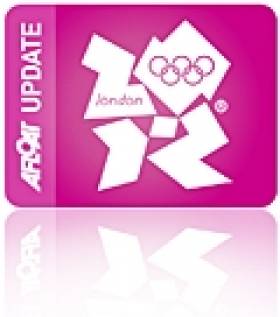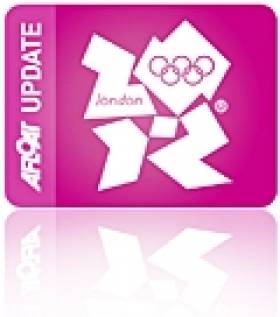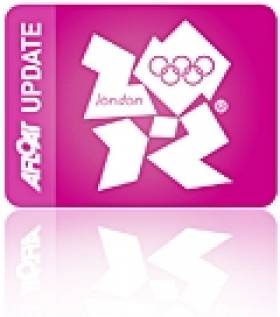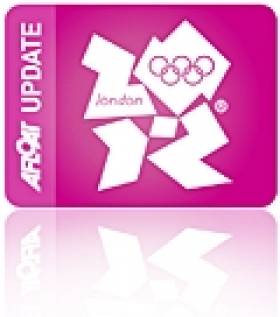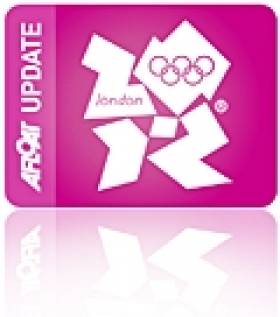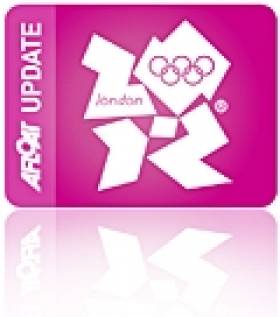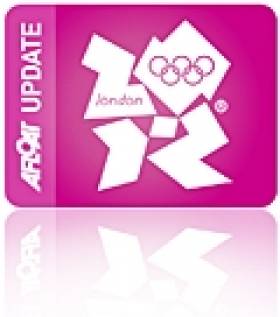Displaying items by tag: Perth
Annalise Murphy Race Win Video
A breathaking 63–metre lead by Annalise Murphy in the second race of the ISAF worlds in Perth this week is captured on youtube (below), The 16-knot performance by the 6 foot 1inch Dun Laoghaire single-hander is well worth a peek. Join the clip around the 20 minutes mark for race commentary,aerial shots and some impressive moves from Annalise! Yes that's a race win against the best in the world!
Murphy Fifth After Mixed Day in Perth
#PERTH2011 – Ireland's first sailor for London 2012, Annalise Murphy of the National Yacht Club in Dun Laoghaire, sailed a further three races in Perth at the ISAF World Sailing Championships today finishing 37th, 17th and 4th respectively to lie fifth overall. There is a further day of racing tomorrow before the top ten competitors progress to the medal race on Sunday. It will be very difficult for her to medal now having a 26 point drift.
In other classes, Ger Owens and Scott Flanigan are currently lying in 34th position in the Gold fleet of the 470 class. They can still qualify Ireland for the Olympics as the top 19 nations will secure a place. They race until Saturday, with the top 10 then proceeding to the medal race on Sunday.
Ross Hamilton in the Finn is in 65th position but will not qualify Ireland for the Olympics at this event burt has one more opportunity at the Finn World Championships next year.
Revised Scoring Puts Annalise Second
#PERTH2011–A revision of the official scoreboard at the ISAF World Sailing Championships in Perth to include the scores of top Belgian girl Evi Van Acker now places Dun Laoghaire's Annalise Murphy in second place overall with eight points. Earlier scores showed Murphy leading the women's Laser Radial class but she now trails the Belgian by two points. The string of superb results for the Irish contender keeps her in contention for tomorrows final series race before the medal race scheduled for Sunday.
Electrical Storms Keep Sailors Ashore in Perth
#PERTH2011 – Electrical storms have forced cancellation of all fleet racing on Day 4 of the Perth 2011 ISAF Sailing World Championships. Ireland's Annalise Murphy, who celebrated an opening race win yesterday, was due to sail as was Finn sailor Ross Hamilton and 470 duo Ger Owens and Scott Flannigan. The Race Committee at the Perth 2011 ISAF Sailing World Championships abandoned all racing at 1350 local time on the afternoon of Day 4, Tuesday 6 December.
After a morning of loud thunder, lightning and sometimes heavy rain, the Race Committee made the decision to abandon racing for the day. The forecast of electrical storms and possible wind gusts up to 100kph continuing through to evening kept the fleet sailors killing time in the boat parks hoping for an afternoon's start.
Despite looming dark skies, Women's Match Racing kicked off on Fremantle's inner harbour at 1000 local time. The first match was one postponed from Sunday because of calm conditions. Easterlies gusting up to 17 knots greeted the two Spanish crews for Tuesday's first flight.
A change in the official race results later in the day gave the match to ESP-2's Silvia Roca and her crew instead of Tamara Echegoyen (ESP-1) as first posted in results.
Mandy Mulder (NED-1) and her crew won the second match by a very convincing 37 seconds against Peru. In contrast, an exciting finish for Olivia Price (AUS-2) when her team beat Genevieve Tulloch (USA-2) by just one second.
The last match of the morning - between Sweden and Brazil - finished with another tight margin - seven seconds - favouring the Brazilians.
Late on Tuesday, the Race Committee announced that all fleet races would start at the earlier local time of 12 noon on Wednesday, 7 December. Competition Manager Skip Lissiman said it was hoped weather conditions would allow an extra race to be sailed in each of the four fleet classes.
The other delayed races will be held on either Thursday or Friday which are nominated lay days, according to each class.
"Safety was the ultimate concern today," Lissiman said. "The electrical storms posed too big a danger to sailors on the water
Murphy Opens Perth Account with Race Win
#PERTH–A race win by Dun Laoghaire's Olympic sailor Annalise Murphy confirms Ireland's pre event billing as a favourite in the Laser Radial class in the opening rounds of the Perth 2012 World Sailing Championships today.
The first day of fleet racing in Perth was held in light, fluctuating breezes as four classes took to the water on Day three of the ISAF Sailing World Championships. With only the lightest of sea breezes reaching just over ten knots, the temperature in Perth soared to 34 degrees.
On the 470 course a top 10 score was posted by fellow Dun Laoghaire sailors Ger Owens and Scott Flanigan.
Other Irish sailors competing today included Ross Hamilton in the Finn who scored a 28th.
Laser Radial
Belgium's Evi van Acker dominated racing in the Yellow Laser Radial Fleet, with the world number two winning both her races.
Meanwhile world fifth ranked sailboarder , Paige Railey (USA) had a mixed day finishing her first race in eighth, before claiming a second place in race two.
In the Blue Fleet, Veronika Fenclova (CZE) and Marit Bouwmeester (NED) were the stand out performers.
Fenclova, the world number three, finished first and third while current World No. 1 Marit Bouwmeester was consistent with a second and a third.
The Laser Radial competition is scheduled to continue on the Parmelia course at 1200 Perth time.
Finns
Five-time Finn world champion Ben Ainslie took an early lead on the first day of his event at the Perth 2011 ISAF Sailing World Championships, winning both his races with ease in the Yellow Fleet.
Ainslie won from the front in the first race but had to come from fifth place to take another win over compatriot and current world champion Ed Wright to put himself firmly at the top of the fleet.
"I didn't have a particularly good start (in the second race) but I was good on the downwind reach and was in front at the second mark," he said.
On why he was so good at downwind sailing, he said: "It has to do with the conditions and technique. After all I have been sailing a lot. You just get into a groove and go with it."
In the Blue Fleet, the 2004 Olympic silver medalist Rafa Trujillo (ESP) led the first race from start to finish while Pieter-Jan Postma (NED), put a poor race behind him to lead all the way and take the second race. Trujillo rounded off a great day with a third place, to end the day in second overall behind Ainslie. A second and a fifth for the 2008 Silver medalist Zach Railey (USA) leaves him in third overall.
The Finn event is scheduled to continue on Tuesday at 1300 Perth time on the Leighton course.
Women's Match Racing
Silke Hahlbrock (GER) put an end to Anna Tunnicliffe's undefeated run in the final flight of Women's Match Racing on Monday, with the German managing to come from behind to get over the line in front as the World No. 1 lagged with sea weed caught on her keel.
In the previous flight, Hahlbrock (GER) had managed to edge out Australia's Nicky Souter, also previously undefeated, in another tight match.
It was also a great day for Finland's Silija Lehtinen, who is yet to lose a match, despite stiff competition throughout the day.
At the conclusion of day three, Finland remained the only undefeated team with USA-1, AUS-1, GER, and NZL also finishing strongly.
Women's Match Racing is scheduled to start on Tuesday at 1000 Perth time on the Inner Harbour course.
Men's 470
Finnish brothers Joonas and Niklas Lindgren were successful on the Success course, winning both Yellow Fleet races on the opening day of the Men's 470 competition on Monday.
A stunning start in race one by Ridgely Balladares and Chavez Rommel (PHI) was overcome by the Finnish sailors, who took and extended their lead to win 34 seconds ahead of runners-up, Kliger Gideon and Eran Sela (ISR).
Phil Sparks and David Kohler (GBR) took an early lead in race two for the Yellow Fleet but the race was won by Mathew Belcher and Malcolm Page with the Lindgren brothers settling for second.
In the Blue Fleet, New Zealand sailors Paul Snow-Hansen and Jason Saunders maintained a strong lead throughout race one, with the real competition occurring for the minor places.
Swedish pair Anton Dahlberg and Sebastian Ostling, Panagiotis Mantis and Pavlos Kagialis (GRE) and France's Pierre Leboucher and Vincent Garos battled throughout the race before finishing second, third and fourth respectively.
While several boats had to be towed out because of light winds ahead of race one, the second round of racing saw an increase in breeze and a light chop.
The last race of the day for Men's 470 Blue Fleet was won by Luke Patience and Stuart Bithell (GBR).
Gabrio Zandona and Pietro Zucchetti (ITA) improved on their previous eighth place to finish second, followed by Sime Fantella and Igor Marenic (CRO).
Women's RS:X
Despite light winds delaying the start of the Women's RS:X competition, the breeze blew in unexpected results for the yellow fleet with World No. 1 Blanca Manchon (ESP) finishing 46th overall with lower than expected finishes in both her races.
Manchon's compatriot Marina Alabau (ESP) fared better, with a third and an 11th place finish putting her in sixth place for the day.
The Chinese Women's RS:X team thrived in the afternoon's light winds, with all four of the country's athletes placing in the top 10 in the Yellow Fleet.
In the Blue Fleet, wins for Lee Korzits (ISR) and Laura Linares (ITA), and solid results in their other race, had the two sailors high in the progressive results.
But Bryony Shaw (GBR) recorded a second and a third to share the overall lead with Korzits.
The Women's RS:X event is scheduled to continue on Tuesday on Centre course at 1230 local time.
O'Leary and Burrows Go Downwind with the 'Doctor' (Video)
#OLYMPIC SAILING–All set for next week's Olympic qualification sailing regatta Irish campaigners Peter O'Leary and David Burrows look in fine form out training in the 'Fremantle doctor'. The consistent wind that blows during Perth's summer time from the southwest proved no object to the pair even when it got up to 28–knots during their downwind session.
The Star (that ceases to be an Olympic class after next year's Olympic regatta) does not use a spinnaker when sailing downwind. Instead, when running downwind a whisker pole is used to hold the jib out to windward for correct wind flow.
Listening to comments from coach Marc Pickel boat you can hear how technical things have become in Olympic keelboat set-up even when sailing in mast breaking weather! O'Leary and Burrows are advised there is 'too much inversion at the spreaders and the solution is to use more mast puller and more top backstay! Maybe not an easy task when you're surfing along in a 700kg keelboat!
O'Leary and Burrow's first race is Sunday week, December 11th so there's a few more days of windy training to come.
Irish Olympic Crews Seeking Qualification in Perth
#OLYMPIC–Ireland takes its place among the world's sailing nations in Perth, Western Australia this weekend for the start of a two-week long sailing championships that is a do or die regatta for Ireland's Olympic squad intent on competing at the London Olympic regatta next July.
There are high hopes that at least two crews will qualify at the ISAF world championships where over 75% of qualification slots are available. Irish officials say Peter O'Leary and David Burrows in the Star keelboat along with Annalise Murphy in the Laser Radial are not only front runners for qualification next week but also Olympic medal prospects.
There is no question both are consistent top 10 performers at world level. There is no question either of their heavy weather performances and as Perth is famous for its strong winds team insiders say a world class result for Ireland is possible.
Murphy won bronze at the Sail for Gold (a dry run of the Olympic regatta) in August and O'Leary won gold (albeit with a different crew) at the same event in 2010.
In the 49er dinghy Ryan Seaton and Matt McGovern are also aiming for the London Games and qualification here is by no means ruled out for the Belfast Lough pair.
Other Irish boats competing in Perth for the London ticket are two times Olympian Ger Owens from Dun Laoghaire now sailing with Howth's Scott Flanigan in the 470 dinghy James Espey will compete in the Laser, while Ross Hamilton will sail in the Finn
First into action on Monday morning will be Hamilton in the Finn. Murphy also has her first race in a 100-strong Laser Radial fleet.
Top international sailors put on a show of strength in Perth's Forrest Place on Friday to help launch the Perth 2011 ISAF Sailing World Championships.
Several thousand people in the CBD watched as the athletes paraded from Barrack Street jetty to the heart of Perth, where they were warmly welcomed by a team of hosts, including Western Australian Premier Colin Barnett.
The athletes had sailed upriver on Rottnest Island ferries from Fremantle, passing under bridges lined with well-wishers, and paraded through the city past a crowd of cheering locals, all braving the 33C heat.
While the Japanese and Korean teams posed for a combined photograph, the New Zealand men squeezed in some rugby practice in the backdrop.
Onlookers lined the streets as the athletes walked behind their national flags, occasionally cheering and posing for photographs.
They were led by a Royal Australian Navy band — described by the Chief Petty Officer Gabe Kicsak as a "rock band on steroids".
Irish flag bearer Scott Flanagan twisted the flag in his hands as he joked that the Perth heat was nothing compared to Ireland's "tropical climate".
Also in the procession was Hungarian windsurfer Aron Gadorvalvi, who could be seen getting a workout with his toddler daughter's pushchair.
Drifting in and out of the procession during the march were Denmark's athletes stocking up on ice-cream.
Among those in the crowd were Trinity Sale (9) and brother Mitchell (6) cheering on their dad, Australian 49er crewman Marty Sale, who will compete with his skipper Duncan Head.
Trinity, who attends Perth's Rawlinson Primary School, said: "I liked it a lot, especially as my dad was marching."
Forrest Place was awash with colour, flags and cameras small and large as the athletes made their entry.
"The Fremantle Doctor is calling — may you all achieve your dreams," ISAF President Goran Petersson said, referring to the world championships and Olympic selection at stake.
The ceremonial part of the event was opened by three Aboriginal dancers, with Dr Richard Walley on the didgeridoo and performing the traditional Welcome to Country.
The Australian anthem was sung by talented Perth busker, Fiona Mariah, a former contestant on a national television talent show.
Marching for the first time were six nations — Kyrgyzstan, St Lucia, Trinidad & Tobago, Cook Islands, Kazakhstan and Montenegro.
The athletes' oath was taken by three-time world champion Marcelien Bos-de-Koning (NED) and the officials' oath by jury chairman Bernard Bonneau.
Perth 2011 chairman Ian Campbell quoted Ernest Hemmingway in his welcome address — from a 1936 magazine article on why people go to sea. "The sea was the last wild place left."
He also quoted at length from a speech made by former USA President John F Kennedy after Australia's challenger Gretel took one race off the American defender Weatherley in the 1962 America's Cup at Newport, Rhode Island.
"It is an interesting biological fact that all of us have in our veins the exact same percentage of salt in our blood that exists in the ocean and therefore we have salt in our blood, in our sweat and in our tears.
"We are tied to the ocean and when we go back to the sea, whether it is to sail or to watch it, we are going back from whence we came."
Mr Campbell said: "I wish all the athletes lots of sweat, as little blood as possible, and tears of joy as you enjoy the magnificent conditions off Fremantle in the coming weeks."
India's coach Mohit Nautiyal said he was confident in his country's team.
"The Finn is definitely our strongest event," Nautiyal said.
"We are very hopeful for gold but [winning] is not very important. We are here because we enjoy sailing," China's team manager Ye Xiao said.
It was clear that most athletes admired the Perth surroundings.
Michael Hestbaek (DEN), a Star class competitor, said: "I originally came (to the opening ceremony) with the idea to have a sail up the river and see the beautiful and spectacular scenery."
"I'm sure there will be more to come," said the three-time world champion in Laser (2) and 49ers (1).
And on his hopes at Perth 2011: "I expect at least three teams to make the top 10 and hope some will medal. I'm hoping to be one of them."
Athletes then flooded the numerous Perth eateries for lunch before catching a train back to Fremantle.
100 Days until Olympic Qualification Begins at Perth 2011
For all the fine performances this year from Ireland's Olympic squad a place on the start line of next year's Olympic regatta is contingent on a result at the next ISAF World championships in 100 days time. It's a do or die event for Annalise Murphy, Peter O'Leary and David Burrows and the rest of the crews who have already shown their Olympic worth at ISAF events this summer but Perth is where 80% of nation places will be dished out.
UK Photographer Ingrid Abery has loaded some excellent breezy weather shots from Weymouth Regatta of Star pairing O'Leary and Burrows onto the Afloat Gallery here.
Perth 2011, the organising committee for the 2011 ISAF Sailing World Championships, will tomorrow (Tuesday 23 August) celebrate a significant milestone with just 100 days to go until the biggest international sailing event of the year.
The World Championships will take place from 3-18 December, with 1200 athletes from 80 nations competing for 10 World Titles in the fresh breezes off Fremantle in Western Australia. The World Championships are also the key qualifier for the sailing competition at the London 2012 Olympic Games, with 75 per cent of places in London being decided in Perth in December.
Perth 2011 Chairman Ian Campbell said that a significant buzz is starting to build around the World Championships.
"Perth and Fremantle provide some of the best conditions for sailing in the world," Campbell said.
"Combine these naturally favourable conditions for the sport with the hospitality and warmth of Fremantle and Western Australia and the Perth 2011 ISAF Sailing World Championships are poised to be memorable.
"The Worlds Festival programme is shaping up very nicely and North Street Productions are committed to ensuring that there is something for everyone attending the World Championships away from the water as well as on it.
"Perth is set for "grandstand sailing" as the Medal Races for each class will be sailed just metres from the shore on Centre Course, allowing spectators to witness the excitement of the World Championships first hand.
"There's a great team working very hard at Perth 2011 to ensure that when the world turns to Perth in December, we'll be ready to provide a wonderful platform for the best young sailors on the planet to realise their World Championships and Olympic Games dreams," Campbell said.
Running parallel to the sailing competition will be the Worlds Festival, a 16 day cultural programme that will include more than 200 free events. The Worlds Festival will be centred on, but not limited to, the Worlds Village on Esplanade Park in Fremantle, with venues around Perth's port city hosting theatre, art exhibitions and music performances through the 16 days of the Worlds Festival.
Murphy Heading for Australian Regatta
The National Yacht Club's Annalise Murphy (Laser Radial) travelled to Australia last weekend for the Perth International Regatta http://www.perth2011.com/ which starts on the 16th of this month. The aim is to gain valuable experience at the venue which will host the December 2011 ISAF World Championships and which will be a vital qualifying event for the the 2012 London Olympic games.
Also heading for Perth is the Royal St. George's Ben Lynch in the high speed 49er dinghy.
After Perth, Annalise travels to Melbourne for the season's first ISAF World Cup event which will be run from Sandringham Yacht Club from 12-19th December. Annalise is currently ranked 20th Womens Laser Radial sailor and 1st under 21 in the World and is campaigning full time to represent Ireland in the 2012 London Olympic Games.
Top youth Laser Radial Sailor Ross Vaughan from the Royal North of Ireland YC has gone down as a training partner for Annalise together with her coach Rory Fitzpatrick.
Also taking part in the Perth Regatta are Irish 49er team of Ryan Seaton and Matt Mc Govern (Ballyholme YC) and Ross Hamilton from the RIYC, Dun Laoghaire.



























